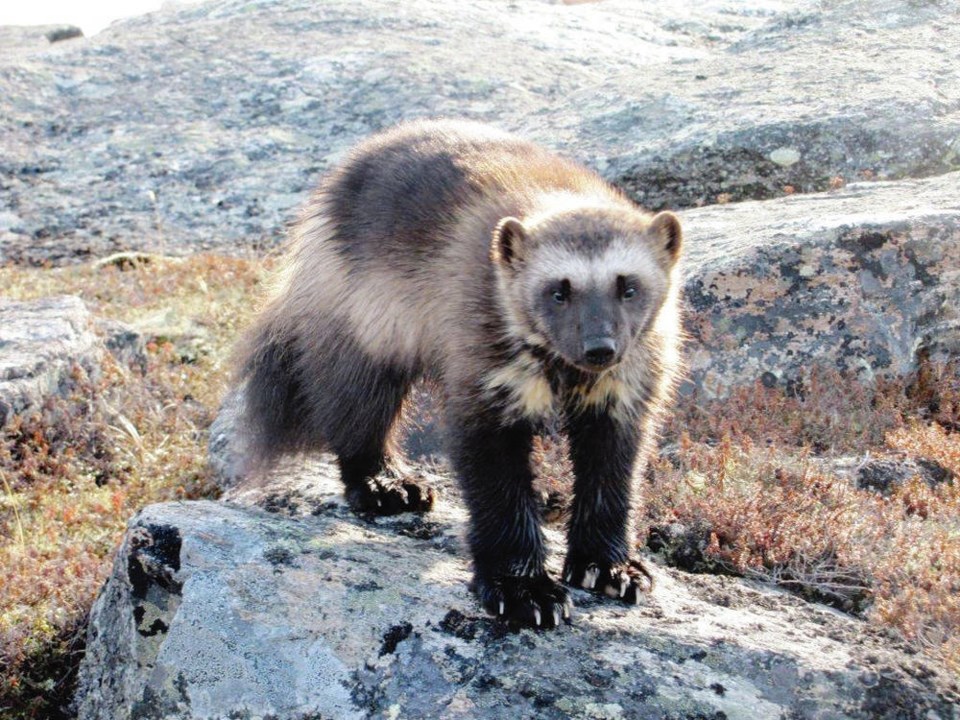Researchers have determined through DNA analysis that the Vancouver Island wolverine — thought to be a subspecies of their mainland cousins for nearly 100 years and more recently believed to be extinct — is actually not that different after all.
Vancouver Island University biology professor Jamie Gorrell and undergraduate student Evan Hessels collected DNA samples from museum skulls, bones and pelts of known wolverines from the Island and compared them with samples of wolverines taken at Bridge River, near Lillooet.
The comparisons showed there was only a small genetic variation — not enough to consider the wolverines on Vancouver Island a unique subspecies, said Hessels.
The study by Hessels and Gorrell, co-authored by wolverine expert Eric Lofroth of Boreas Ecological consulting and Rich Weir from the B.C. Environment Ministry, was published last month in the Journal of Mammalogy.
It throws cold water on the belief that the Island wolverine evolved independently here after being cut off from the mainland thousands of years ago, when ocean levels rose and severed a land bridge. The theory was similar to one explaining the evolution of the Vancouver Island marmot (Marmota vancouverensis) into its own distinct species.
The Island wolverine was first identified as a subspecies in 1935 and thought to be different based on subtle variations in skull and bone measurements, said Gorrell. Hessels said further studies in the 1980s using full skeletons also noted “small differences.”
But recent evidence has shown collared wolverines can swim up to five or six kilometres, said Gorrell, suggesting wolverines might have been populating the Island by island-hopping, likely through the Johnstone Strait between Port McNeill and Campbell River, similar to the recent behaviour of grizzly bears, which have been showing up near Sayward for several years.
There hasn’t been a confirmed sighting of a wolverine on Vancouver Island since 1992, although there are unconfirmed sightings almost every year, said Gorrell, including one as recently as two weeks ago at a log sort near Sayward.
Wolverine spotters have created a group on Facebook — Vancouver Island Wolverine Sightings — to share what they’ve seen and where.
“It’s the Island’s version of Sasquatch,” said Gorrell.
The population of wolverines on the Island isn’t known, largely because of the elusive nature of the animal. It lives in remote areas and stays far away from people and human activity, with rare sightings usually in alpine areas of the North Island, said Gorrell.
The voracious carnivore weighs up to 80 pounds, eats marmots, squirrels and deer, and has been known to take down even larger prey and fight bear over carcasses, said Gorrell. It is the largest terrestrial member of the weasel family and is related to the fisher and marten.
The Committee on the Status of Endangered Wildlife in Canada lists the wolverine’s western population as of “special concern,” with about 13,000 ranging from the Island to Ontario.
Scientists say wolverine habitat is increasingly fragmented by industrial activity such as logging and increased motorized access. The species has a low reproductive rate and requires vast secure areas to maintain viable populations.
Gorrell said male wolverines have been known to wander over 800 square kilometres of range in search of food and mates, while females can cover up to 300 square kilometres.
Resolving the subspecies question could allow for mainland wolverines to be relocated to the Island as part of conservation efforts. However, Gorrell said that could be dangerous for the survival of the Vancouver Island marmot, the most critically endangered mammal in Canada.
The Vancouver Island wolverine is red-listed by the provincial government, which means the species is considered threatened or at risk of being lost to extinction. Last year, the Nature Conservancy of Canada listed the Island wolverine as one of 308 species of mammals, plants and invertebrates found only in Canada — 105 of which are in British Columbia.
Hessels said Island wolverine specimens collected from the Royal B.C. Museum, the Beaty Biodiversity Museum at the University of British Columbia as well as bone and hide samples from the University of Colorado and University of California at Berkeley were used to extract DNA for analysis.
He noted some of the samples were more than 100 years old, but researchers found enough usable DNA by drilling into molars and the nails of tanned pelts, as well as marrow on skulls and bones.
Samples were taken from the remains of 12 individual Island wolverines, resulting in five viable DNA profiles.
“It was fascinating research and I’m pretty excited to have my research published in the Journal of Mammalogy,” said Hessels, 24, a Nanaimo native.
“I hope this research helps contribute to the conservation of wolverines moving into the future.”
Hessels completed his DNA analysis as part of his fourth-year undergraduate research project. He is also the recipient of a Vancouver Island University REACH Award, which provides students with a stipend to help them complete their own independent research project under the mentorship of a VIU faculty member. The project was funded by a VIU Inquiry Grant and a Natural Sciences and Engineering Research Council of Canada Discovery Grant, which was awarded to Gorrell.



